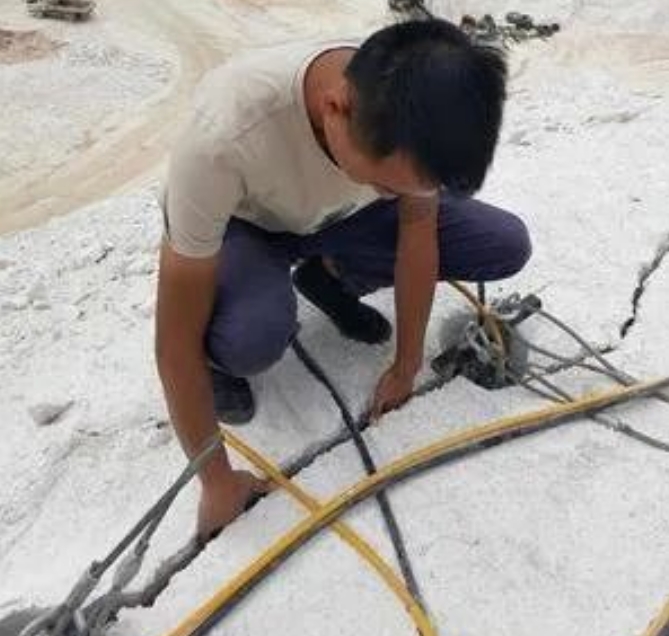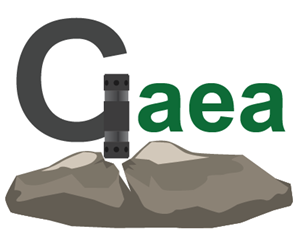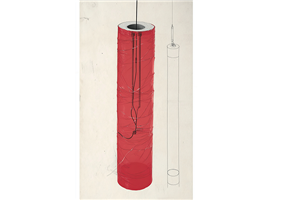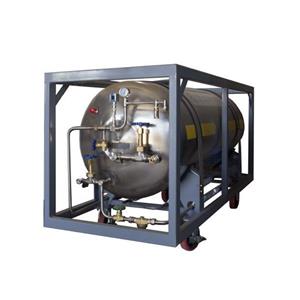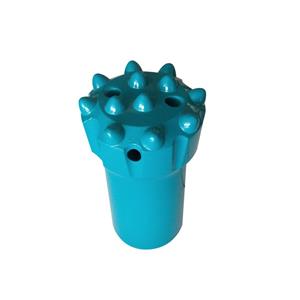New Blasting Technology-Static Blasting
Related Products:CO2 rock blasting system
1 Working Principle
Static crushing is a new method of crushing or cutting rocks and concrete developed in recent years. It is also called static force cracking or static crushing technology. Its main principle is to use the static crushing agent (English name: High Rang Soundless Cracking Agent, HSCA for short) installed in the medium borehole to react with water to cause the crushing agent crystal to deform and expand in volume, thereby slowly and quietly applying expansion pressure (up to 30Mpa-50Mpa) to the hole wall. After a period of time, it reaches the maximum value and crushes the medium.
Static crushing agent is the core of this new technology. It is a non-combustible, non-explosive, non-toxic item. It is a powdered inorganic material with high expansion performance containing elements such as aluminum, magnesium, calcium, iron, oxygen, silicon, phosphorus, and titanium (usually also called: static crushing agent, static blasting agent, expansion cracking agent, static cracking agent, expansion agent, crushing agent, blasting agent, silent explosive, stone breaking agent, stone cracking agent, etc.). It is mainly calcined in a rotary kiln, with quicklime (calcium oxide) as the main body, and an appropriate amount of admixtures are added to grind it together. It is suitable for use in the range of -5℃-35℃. Beyond this temperature range, auxiliary measures should be taken. It can be widely used in the silent crushing and demolition of concrete structures and rock mining, solving the problem of blasting engineering construction that does not allow the use of explosives but must crush concrete or rocks. It is a new, environmentally friendly, non-explosive construction material popular internationally.
2 Features
Compared with traditional blasting, static blasting has the following characteristics:
2.1 Safe and easy to manage. Static blasting agents are non-explosive dangerous goods. Detonators and explosives are not required during construction, and various licenses required for conventional explosive blasting are not required. Special types of work such as blasting are not required during operation. Crushing agents can be purchased, transported, and used like other ordinary goods.
2.2 Environmentally friendly materials. It is silent, vibration-free, without flying stones, no toxic gas, and no dust during use. It is an internationally popular pollution-free and environmentally friendly product.
2.3 Simple construction and easy operation. Just mix it with water and pour it into the drill hole.
2.4 Easy to use. According to the crushing requirements, the appropriate hole diameter, hole spacing and angle are designed to achieve "surgical" splitting and cutting of rocks and concrete. For rock mining, the stone yield rate can be increased by 3-4 times.
2.5 Its superiority is more evident under environmental conditions that are not suitable for explosive blasting. The latest roll-type crushing agent has a wider applicable ambient temperature range (-5℃ to 40℃), is more convenient to use and has greater effectiveness.
3 Scope of application
3.1 Urban buildings, large equipment concrete demolition, construction, gardening, decoration, municipal, highway, water conservancy, electricity, communications, railways and other projects that require "static blasting method" crushing construction.
3.2 Concrete projects and rock loosening projects that need to be demolished under conditions where explosive blasting and mechanical crushing are not allowed or not suitable. For example, it is prohibited to carry out crushing and demolition construction near oil tanks, gas tanks, oil and gas pipelines, explosives depots, dangerous goods warehouses, and arsenals where ignition points, open flames, and high temperatures are prohibited.
3.3 Construction near railway double-tracks, high-voltage transmission lines, communication optical cables, government schools, public places, and dense residential areas where flying rocks are not allowed or appropriate.
3.4 Crushing construction that does not allow or is not appropriate to cause strong vibrations, such as building retention and demolition, slope danger treatment, cultural relics rescue and protection projects, and underground projects around existing pipelines.
3.5 Crushing construction that does not allow or is not appropriate to cause loud sounds or noises. For example, crushing construction in the city late at night.
3.6 Mining and cutting of precious rocks.
3.7 Slope treatment projects that require under-excavation treatment and simultaneous excavation and support.
4 Construction process
The construction process of static crushing is very simple: for the crushed medium, after reasonable crushing design (determination of hole diameter, hole spacing, etc.) and drilling, the powdered crushing agent is mixed with appropriate amount of water into a flowing slurry and directly injected into the drill hole. After half an hour or several hours (mainly determined by the water-cement ratio), the medium (the tensile strength of rock is 5-10Mpa or the tensile strength of concrete is 2-6Mpa) will expand and break by itself. This process can be represented by the following flow chart. As can be seen from the figure, the construction process is concise and clear.
Preparation before construction → design hole layout → measurement and positioning → drilling → charging → reagent reaction, slag removal → enter the next cycle.
5 Operation points
5.1 Before crushing, the structure, nature, working environment, engineering quantity, crushing degree, construction period requirements, climatic conditions, steel bar specifications and reinforcement configuration of the building or structure should be investigated in detail; rock crushing requires understanding of rock properties, joints, orientation and groundwater conditions. The drilling parameters, drilling distribution and crushing sequence need to be determined according to the actual situation of the crushing object (material type, steel bar configuration, rock properties, crushing or cutting speed, etc.).
5.2 Before laying the hole, it is necessary to first determine that there is at least one free surface, and the drilling direction should be as parallel to the free surface as possible. The more free surfaces there are, the greater the unit rock breaking volume and the higher the economic benefits. When cutting rocks, the same row of holes should be kept on the same plane as much as possible. The size of the hole spacing and row spacing is directly related to the hardness of the rock, the strength of the concrete and the reinforcement. The greater the hardness, the higher the concrete strength, the denser the reinforcement and the thicker the reinforcement, the smaller the hole spacing and row spacing, and vice versa.
5.3 The diameter of the drilling hole is directly related to the crushing effect. If the drilling hole is too small, it is not conducive to the full effectiveness of the agent; if the drilling hole is too large, the air mouth is difficult to block. The remaining water in the hole should be blown clean with high-pressure air, and the area around the hole should be clean and free of soil and stone debris.
5.4 The drilling depth of isolated rocks (or concrete blocks) is 80%-90% of the target crushed body. The drilling depth of mining waste materials can reach about 6m. For large-volume rocks (or concrete blocks) that need to be crushed step by step, the drilling depth can be selected according to the construction requirements, generally about 1-2m. The charging depth is 100% of the hole depth.
6 Safety measures
6.1 During static crushing, if an abnormal situation occurs, the operation must be stopped. After finding out the cause and taking corresponding measures to ensure safety, construction can be continued.
6.2 When using corrosive static blasting agents, grouting personnel must wear protective gloves and protective glasses. After the crushing agent is injected into the hole, the operator should keep a safe distance and it is strictly forbidden to walk in the injection area. It is strictly forbidden to drill or inject crushing agents between two adjacent holes.
6.3 Before the agent is injected into the borehole until the rock or concrete cracks, the face should not be directly facing the charged borehole at close range. After the agent is filled, cover it with a sack or palm mat and stay away from the filling point. Be more careful when observing the development of cracks. In addition, clean water and towels are specially prepared at the construction site. If the agent gradually enters the eyes or skin during punching, it should be rinsed with clean water immediately. Those in serious cases should be sent to the hospital for treatment immediately.
6.4 If the reaction time needs to be changed and controlled during crushing construction, inhibitors and accelerators must be added in accordance with regulations, and they must be configured and used as required. It is strictly forbidden to add any other chemicals without authorization.
6.5 The wall temperature of the hole that has just been drilled or punched is relatively high. It should be ensured that the temperature is normal and meets the requirements and cleaned before continuing to load the agent.
6.6 The transportation and storage of crushing agents should be moisture-proof and used immediately after opening. If it is not used up at one time, the bag mouth should be tied up immediately and opened when needed. It is strictly forbidden to mix crushing agents with other materials.
